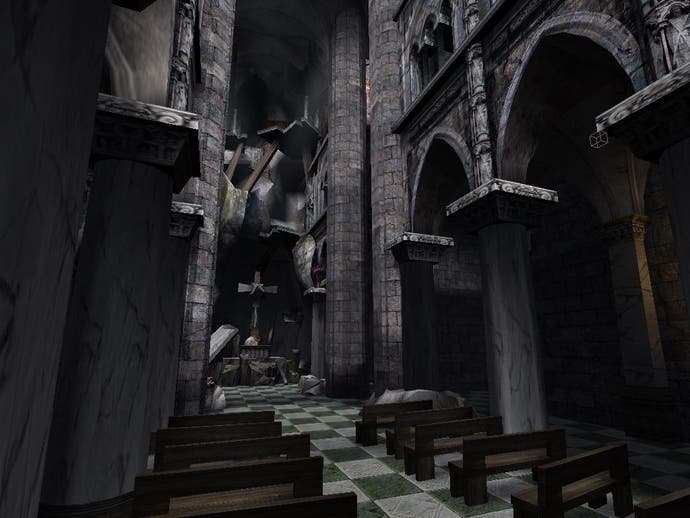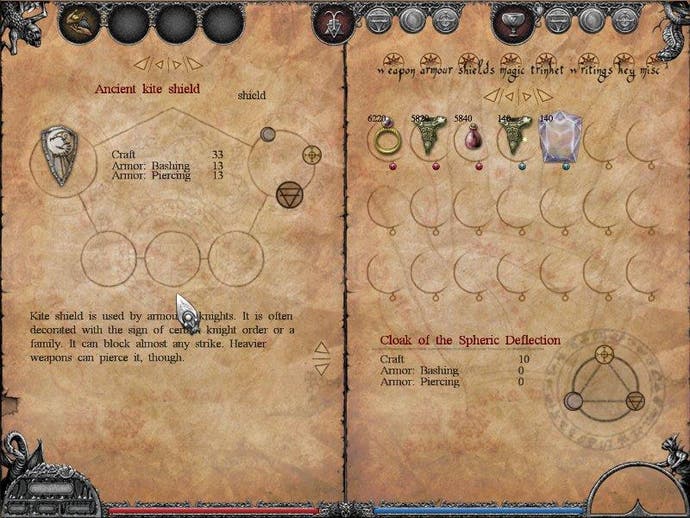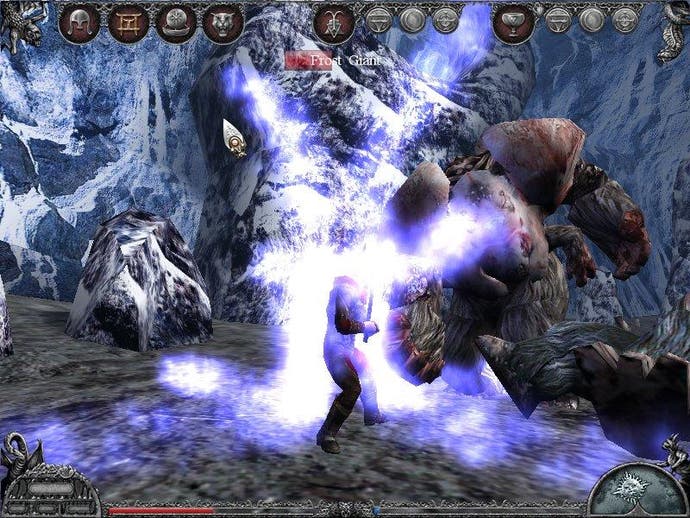Mistmare
We take a look at Arxel Tribe's baffling action RPG
Of all the games that we saw at ECTS last week, the one which confused us the most was Mistmare. At first sight it's a Morrowind style first person action role-playing game, but lurking behind that attractive 3D facade is an inventive character development system and a truly bizarre setting.

Scotch Mist
Mistmare takes place in a parallel world where the Catholic church started researching Lithurgic magic, eventually creating The Link, a network of magical bells that allowed communication between cathedrals across Europe.
Needless to say this put the church in a position of great power, but things soon took a turn for the worse as the Black Death took hold of the continent. The Link was broken, and a mysterious magical Fog began to spread across Europe. By the time its progress was stopped it had already smothered most of central Europe, from deep in Russia across eastern Europe, along the alps and out into the Atlantic. Anybody who strayed into the Fog vanished, and in the meantime monsters and demons had started to emerge from beyond the barrier.
Flash forwards to 1996, and we have a very different world to the one we're familiar with. Central Europe is still smothered in the Fog, the Mediterranean is dominated by the church, while Scandinavia is all but cut off in the north and has developed its own primitive technology. You are thrown into this sundered world in the role of a young monk and sorceror, sent by the Inquisition to track down a dangerous man who could make things even worse. Along the way you will start to uncover the origins and nature of the Fog, while numerous side quests and randomly generated missions will sidetrack you from the main storyline.

My Brain Hurts
Not only is this one of the more colourful back stories that we've come across in a role-playing game recently, but it also acts as a logical basis for the game's unique character development and spell casting systems. The lithurgic magic of this alternative Europe is based around the idea that the world is governed by three spheres - Terran, Lunar and Solar - while people have both Corporeal and Spiritual aspects. This ties into everything from skills and attributes to combat and magic.
Your six basic stats represent the two aspects of each of the three spheres - willpower and strength are (respectively) the Spiritual and Corporeal aspects of the Terran sphere, intelligence and agility belong to the Lunar sphere, and concentration and health are Solar attributes. One or more of these basic stats then controls each skill; so, for example, acrobatics is a Corporeal skill governed by your agility and strength.
It's all very complicated, but luckily most of this intricacy is hidden away behind a very simple interface and character sheet. Each item and skill has a balance of the three spheres, displayed as a triangle with a circle at each corner, with the size of a sphere's icon showing the strength of its influence. This pictorial approach is extended to the stats themselves; instead of giving the player a sheet full of numbers, you are simply shown bars that extend as you gain experience in that particular attribute or skill, until eventually you "level" it and another star lights up above the bar.

Gotta Harvest Them All
The most obvious application of lithurgica in the game is the magical system. Spells are cast by combining a focus with one of the three spheres, with the outcome varying depending on which sphere you used. For example, using a particular focus for a Terran spell will make you move silently, while the Lunar sphere allows you to creep through the shadows and the Solar makes your body translucent.
Spells range from basic alchemy and boosting or reducing the stats of a given creature to offensive spells that cause fire storms, lightning strikes and explosions. To make things even more mind-boggling, your alignment also has an influence on the outcome of your spells. Lawful characters tend to be luckier, neutral people excel at alchemy, and chaotic ones are best at offensive magic. And naturally your alignment will also govern how other characters respond to you.
The game also includes a bit of a Pokemon side to it, with characters able to harvest monsters, locking them in gems and then reconjuring them at a later date. The creatures are controlled using a simple point and click interface, allowing you to order monsters to move to a specific point or attack a particular target. If you prefer a more hands-on approach to fighting, the game includes four different schools of combat to master - oriental, norse, military and barbaric - with a range of unique moves for each.

Perfect Timing
During the course of the game you will get to venture behind the barrier and into the Fog, which adds another level of complexity to character development and combat. Fighting in the Fog will "damage" your concentration rather than your health, and winning a fight in the Fog will benefit your Spiritual attributes, while victory in the world outside improves your Corporeal stats.
Whether it's your mind or your body that is under attack though, if you lose a battle your character will run or hobble away to recover. This costs you time, which is a precious commodity in Mistmare. You only have a limited number of days to complete each episode, and it's up to you how you spend this time. For example, if you want your character to work out, you can simply give the order to pump iron for however long you want, and the world will accelerate around you until the activity is completed. At this point your strength skills will have been boosted, but you'll have less time left to complete your mission. You also need to set aside some time to sleep, as your stamina limit will gradually decrease day by day as you exhaust yourself.
The passing of time affects the world around you as well, because in contrast to the likes of Morrowind, in Mistmare day and night aren't just there to look pretty. The world isn't static - people have daily routines and will go home at night, so if you urgently need to buy or sell something in the middle of the night you may have to track down a dodgy looking bloke at the local pub, as all the shops will be closed.
Conclusion
Mistmare is an ambitious and inventive effort with a vast and unusual world to explore, attractive 3D graphics and a carefully thought out magical and character development system that ties into almost every aspect of the game. To be honest we were a bit baffled by the glimpse we got of this world at ECTS but hopefully all will become clear soon, as the game is currently on target for release towards the end of the year.



.png?width=291&height=164&fit=crop&quality=80&format=jpg&auto=webp)



